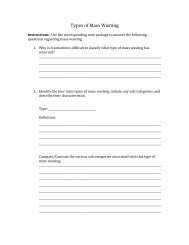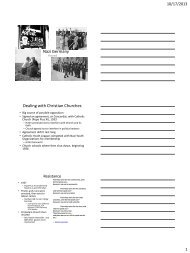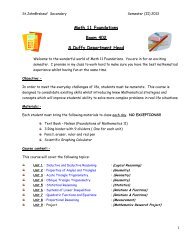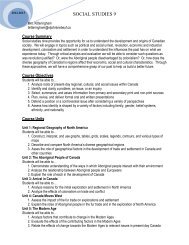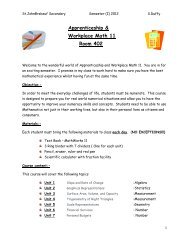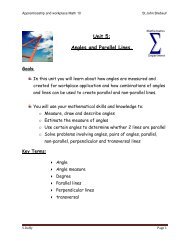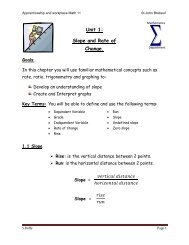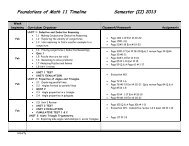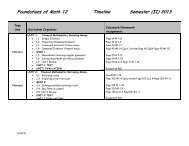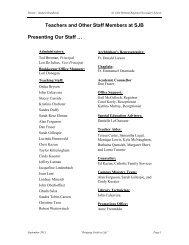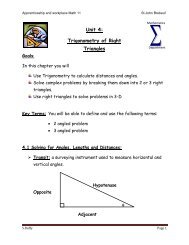Unit 3: Surface Area, Volume and Capacity - St John Brebeuf
Unit 3: Surface Area, Volume and Capacity - St John Brebeuf
Unit 3: Surface Area, Volume and Capacity - St John Brebeuf
Create successful ePaper yourself
Turn your PDF publications into a flip-book with our unique Google optimized e-Paper software.
Apprenticeship <strong>and</strong> workplace Math 11<br />
<strong>St</strong>.<strong>John</strong> <strong>Brebeuf</strong><br />
<strong>Unit</strong> 3:<br />
<strong>Surface</strong> <strong>Area</strong>, <strong>Volume</strong><br />
<strong>and</strong> <strong>Capacity</strong><br />
Mathematics<br />
Department<br />
Goals:<br />
In this chapter you will<br />
Estimate <strong>and</strong> calculate the surface area of a 3-D object.<br />
Estimate, measure <strong>and</strong> calculate the volume of 3-D objects.<br />
Modify your surface area <strong>and</strong> volume measurements when their<br />
dimensions increase or decrease.<br />
Explore the relationship between several objects <strong>and</strong> determine<br />
how their volumes are related.<br />
Key Terms: You will be able to define <strong>and</strong> use the following terms:<br />
Cone<br />
Cylinder<br />
Dimension<br />
Prism<br />
Pyramid<br />
Sphere<br />
<strong>Surface</strong> <strong>Area</strong><br />
<strong>Volume</strong><br />
capacity<br />
S.Duffy Page 1
Apprenticeship <strong>and</strong> workplace Math 11<br />
<strong>St</strong>.<strong>John</strong> <strong>Brebeuf</strong><br />
3.1 <strong>Surface</strong> <strong>Area</strong> of Prisms:<br />
‣ Net: 2-D pattern that can be folded to form a 3-D shape .<br />
‣ Rectangular Prism: A 3-D shape with ends that are congruent<br />
rectangles <strong>and</strong> with sides that are parallelograms<br />
Rectangular Prism<br />
Net of Rectangular Prism<br />
‣ <strong>Surface</strong> <strong>Area</strong>: The <strong>Area</strong> required to cover a 3-D shape.<br />
The surface area is calculated by adding up all the areas of<br />
the surfaces of the net of the shape.<br />
‣ Prism: A 3-D shape with ends that are congruent polygons <strong>and</strong><br />
sides that are parallelograms.<br />
‣ Congruent Polygons: have<br />
The same shape <strong>and</strong> size<br />
Sides <strong>and</strong> angles in the same position.<br />
S.Duffy Page 2
Apprenticeship <strong>and</strong> workplace Math 11<br />
<strong>St</strong>.<strong>John</strong> <strong>Brebeuf</strong><br />
‣ Base: One of the parallel faces of a prism.<br />
‣ Lateral Face: A face that connects the bases of a prism<br />
Lateral Face<br />
Base<br />
Base<br />
Example 1:<br />
David builds a fence around his yard. To make the gate he cuts four<br />
pieces of 2 x 4 lumber for a frame <strong>and</strong> one piece as a diagonal brace to<br />
keep the gate from sagging. For the fence posts he uses 2 x 2 lumber<br />
<strong>and</strong> cuts the ends at 45 , as shown below.<br />
2 x 2 lumber<br />
2 x 4 frame 45 each end<br />
Garden gate<br />
Fence posts<br />
S.Duffy Page 3
Apprenticeship <strong>and</strong> workplace Math 11<br />
<strong>St</strong>.<strong>John</strong> <strong>Brebeuf</strong><br />
a) What is the shape of each of the pieces he uses for the frame<br />
b) What is the shape of the brace<br />
c) What is the shape of each of the pickets<br />
Solution:<br />
a) __________________________________________________<br />
b) __________________________________________________<br />
c) ___________________________________________________<br />
Example 2:<br />
Nicola ships posters in a holder the shape of an equilateral triangular<br />
prism:<br />
96.5cm<br />
15.2cm<br />
13.2cm<br />
15.2cm<br />
a) Draw the net of the box <strong>and</strong> label the dimensions of each side.<br />
b) Calculate the surface area of the box.<br />
S.Duffy Page 4
Apprenticeship <strong>and</strong> workplace Math 11<br />
<strong>St</strong>.<strong>John</strong> <strong>Brebeuf</strong><br />
Solution:<br />
a)<br />
b) <strong>Area</strong> of one rectangle: <strong>Area</strong> of one triangle<br />
A = l x w A = bh<br />
= = x<br />
= =<br />
<strong>Surface</strong> <strong>Area</strong> = 3 Rectangles + 2 Triangles<br />
=<br />
=<br />
=<br />
S.Duffy Page 5
Apprenticeship <strong>and</strong> workplace Math 11<br />
<strong>St</strong>.<strong>John</strong> <strong>Brebeuf</strong><br />
Example 3:<br />
Katie is building a child’s wagon. The wagon’s box is to be 3 feet long<br />
<strong>and</strong> 18 inches wide. The sides of the wagon will be 10 inches high.<br />
a) Draw a net of the wagon.<br />
b) Calculate the surface area of the box<br />
in square inches.<br />
c) If 1ft 2 = 144 in 2 calculate the surface area of the<br />
box in square feet.<br />
d) Can she make the box from a single sheet of 4ft x 8ft plywood<br />
Solution:<br />
a)<br />
b) <strong>Surface</strong> <strong>Area</strong> = area of base + area of ends + area of sides<br />
=<br />
=<br />
S.Duffy Page 6
Apprenticeship <strong>and</strong> workplace Math 11<br />
<strong>St</strong>.<strong>John</strong> <strong>Brebeuf</strong><br />
c)<br />
96 in<br />
d) 4ft x 8ft<br />
= 48in x 96 in 48in<br />
Complete notebook assignment page 124 # 1-6<br />
S.Duffy Page 7
Apprenticeship <strong>and</strong> workplace Math 11<br />
<strong>St</strong>.<strong>John</strong> <strong>Brebeuf</strong><br />
3.2: <strong>Surface</strong> <strong>Area</strong> of Pyramids, Cylinders, Spheres <strong>and</strong> Cones:<br />
Pyramid Cylinder Sphere Cone<br />
‣ Pyramid: A 3-D shape with a base of a polygon <strong>and</strong> lateral sides<br />
that are all triangles<br />
‣ Cylinder: A 3-D shape with 2 circular bases that are parallel <strong>and</strong><br />
congruent; the side is a rectangle that is wrapped around the<br />
circular bases at the ends.<br />
‣ Sphere: A 3-D shape whose surface consists of points that are<br />
all the same distance from the centre of the shape.<br />
‣ Cone: A 3-D shape with a circular base <strong>and</strong> a vertex opposite the<br />
base<br />
‣ The method for calculating the <strong>Surface</strong> <strong>Area</strong> of these objects is<br />
the same as for prisms:<br />
Add up all the individual surfaces that make up the object<br />
S.Duffy Page 8
Apprenticeship <strong>and</strong> workplace Math 11<br />
<strong>St</strong>.<strong>John</strong> <strong>Brebeuf</strong><br />
Example1:<br />
Calculate the surface area of the cylinder below in square feet<br />
Diameter = 30 in<br />
Solution:<br />
Length= 24 in<br />
Diameter = 30in<br />
Length 24 in<br />
S.Duffy Page 9
Apprenticeship <strong>and</strong> workplace Math 11<br />
<strong>St</strong>.<strong>John</strong> <strong>Brebeuf</strong><br />
Example 2:<br />
Calculate the surface area of the sphere below, whose diameter is 1.5<br />
metres.<br />
1.5m<br />
Solution:<br />
<strong>Surface</strong> <strong>Area</strong> of a Sphere = 4 r 2<br />
=<br />
=<br />
Example 3:<br />
Calculate the surface area of the composite shape below, where the<br />
radius of the hemisphere <strong>and</strong> cone are 9m, the slant height of the cone<br />
is 15m <strong>and</strong> the length of the cylinder is 20m.<br />
15m<br />
9m<br />
9m<br />
20m<br />
S.Duffy Page 10
Apprenticeship <strong>and</strong> workplace Math 11<br />
<strong>St</strong>.<strong>John</strong> <strong>Brebeuf</strong><br />
Solution:<br />
SA = <strong>Area</strong> of the hemisphere + <strong>Area</strong> of cylinder + <strong>Area</strong> of Cone<br />
= + 2 r 2 + d + rs<br />
Why don’t we count these 2 circles<br />
Example 4:<br />
Use r to represent the radius of the small sphere, compare the surface<br />
areas of the 2 spheres below:<br />
r<br />
3r<br />
Sphere A<br />
Sphere B<br />
S.Duffy Page 11
Apprenticeship <strong>and</strong> workplace Math 11<br />
<strong>St</strong>.<strong>John</strong> <strong>Brebeuf</strong><br />
Solution:<br />
S.A. = rs<br />
Example 4:<br />
Maureen is estimating the cost to re-shingle her roof.<br />
To determine the number of shingles, she must calculate the surface<br />
area of the roof. The roof is shaped like a pyramid with each base side<br />
having a base length of 25 ft <strong>and</strong> a slant height of 15 ft 3 in.<br />
a) What is the total surface area she needs to cover<br />
b) Each shingle has dimensions long by wide.<br />
Maureen calculates the area of 1 shingle <strong>and</strong> divides the<br />
area of the roof by the area of the shingle to determine the<br />
number of shingles she will need.<br />
Will she buy the right quantity of shingles using this<br />
method<br />
S.Duffy Page 12
Apprenticeship <strong>and</strong> workplace Math 11<br />
<strong>St</strong>.<strong>John</strong> <strong>Brebeuf</strong><br />
c) Shingles are sold in bundles of (15-20) which cover 30 ft 2 .<br />
How many bundles will she need<br />
d) Each bundle costs $31.50. What is the total cost of the shingles<br />
Solution: SA of a pyramid = b 2 + 4 x b x h<br />
Why do we not count the base 2 in this example<br />
a)<br />
b)<br />
c)<br />
d)<br />
Complete notebook assignment page 134 # 1-4<br />
S.Duffy Page 13
Apprenticeship <strong>and</strong> workplace Math 11<br />
<strong>St</strong>.<strong>John</strong> <strong>Brebeuf</strong><br />
3.3 <strong>Volume</strong> <strong>and</strong> <strong>Capacity</strong> of Prisms <strong>and</strong> Cylinders.<br />
‣ <strong>Volume</strong>: The measure of the space a 3-D<br />
object occupies, measured in units such as cm 3 , m 3 .<br />
‣ <strong>Capacity</strong>: The amount a 3-D object can hold,<br />
measured in units such as litres or gallons.<br />
‣ <strong>Capacity</strong> <strong>and</strong> <strong>Volume</strong> are closely related. <strong>Capacity</strong> is the amount<br />
of material that can be contained in a hollow volume.<br />
Hollow objects have volume <strong>and</strong> capacity.<br />
Solid objects have only volume.<br />
Example 1<br />
Louis sells different sizes of fish tanks in his pet store.<br />
20cm<br />
60cm<br />
20cm<br />
40cm<br />
20cm<br />
20cm<br />
20cm<br />
20cm<br />
20cm<br />
Tank 1<br />
Tank 2<br />
Tank 3<br />
a) How much water will be needed to fill each tank<br />
b) Look at tanks 2 & 3, how many dimensions have changes By how<br />
much How does the volume of tank 2 compare to that of tank 3<br />
c) Look at tanks 1 & 3, how many dimensions have changes By how<br />
much How does the volume of tank 1 compare to that of tank 3<br />
d) 1000cm 3 = 1 litre. Convert the 3 volumes into capacity in litres.<br />
S.Duffy Page 14
Apprenticeship <strong>and</strong> workplace Math 11<br />
<strong>St</strong>.<strong>John</strong> <strong>Brebeuf</strong><br />
Solution:<br />
a) V 1 = l x w x h V 2 = l x w x h V 3 = l x w x h<br />
b)<br />
_____________________________________________________<br />
_____________________________________________________<br />
_____________________________________________________<br />
c)<br />
____________________________________________________<br />
____________________________________________________<br />
____________________________________________________<br />
d) Tank 1 Tank 2 Tank 3<br />
S.Duffy Page 15
Apprenticeship <strong>and</strong> workplace Math 11<br />
<strong>St</strong>.<strong>John</strong> <strong>Brebeuf</strong><br />
Example 2.<br />
Shapes called climbing grips are inserted into climbing walls for<br />
climbers to grasp. Some climbing grips are made of polyester resin<br />
that is poured into moulds of different shapes.<br />
A mould for a cylindrical grip has a radius of 1.5 in <strong>and</strong> a height of 3 in.<br />
The machine that pours the moulds must fill each mould.<br />
What is the volume of the mould<br />
Solution: <strong>Volume</strong> of a cylinder = <strong>Area</strong> of the base x height<br />
V<br />
= r 2 x h<br />
Example 3.<br />
1<br />
2 4<br />
1 2 4<br />
1 2 4<br />
a) Determine the volume of each box.<br />
b) As the lengths are doubled, what happens to the volume Explain<br />
your answer.<br />
S.Duffy Page 16
Apprenticeship <strong>and</strong> workplace Math 11<br />
<strong>St</strong>.<strong>John</strong> <strong>Brebeuf</strong><br />
Solution:<br />
a) V 1 = V 2 V 3<br />
b)<br />
Example 4.<br />
Engine displacement is the volume swept by the pistons in an engine’s<br />
cylinders.<br />
The following formula can be used to calculate engine displacement.<br />
Engine displacement = [<br />
] 2 (stroke)(# cylinders)<br />
The bore is the diameter of the engine’s cylinder. The stroke is the<br />
distance that the piston moves in the cylinder<br />
S.Duffy Page 17
Apprenticeship <strong>and</strong> workplace Math 11<br />
<strong>St</strong>.<strong>John</strong> <strong>Brebeuf</strong><br />
A 4-cylinder engine has a stroke of 82mm <strong>and</strong> a bore of 75.5mm<br />
a) What is the engine displacement in cm 3 <br />
b) Calculate the engine displacement in litres.<br />
c) [1 inch = 2.54cm.] What is the displacement of the engine in part a<br />
in cubic inches<br />
d) A car with a larger engine displacement generates more power than<br />
one with a smaller engine displacement. How would this displacement<br />
change if the stroke were doubled<br />
e) How would the displacement change if the bore were doubled<br />
Solution:<br />
a) Engine displacement = [ ] 2 (stroke)(# cylinders)<br />
b)<br />
S.Duffy Page 18
Apprenticeship <strong>and</strong> workplace Math 11<br />
<strong>St</strong>.<strong>John</strong> <strong>Brebeuf</strong><br />
c)<br />
_____________________________________________________<br />
_____________________________________________________<br />
_____________________________________________________<br />
d)<br />
____________________________________________________<br />
____________________________________________________<br />
____________________________________________________<br />
e)<br />
____________________________________________________<br />
____________________________________________________<br />
____________________________________________________<br />
____________________________________________________<br />
Complete notebook assignment page 144 # 1-6<br />
S.Duffy Page 19
Apprenticeship <strong>and</strong> workplace Math 11<br />
<strong>St</strong>.<strong>John</strong> <strong>Brebeuf</strong><br />
3.4 <strong>Volume</strong> <strong>and</strong> <strong>Capacity</strong> of Spheres, Cones <strong>and</strong> Pyramids:<br />
<strong>Volume</strong> cone<br />
= x area of base x height<br />
<strong>Volume</strong> pyramid = x area of base x height<br />
<strong>Volume</strong> sphere = x r 3<br />
Example 1:<br />
A tennis ball has a diameter of 6.7 cm.<br />
a) What is the volume of the tennis ball<br />
b) Tennis balls are commonly sold in cylindrical tubes in packs of three<br />
per tube. What is the volume of the container<br />
c) What is the ratio of the volume of the three balls to the volume of<br />
the container<br />
d) Using r to represent the radius, show that the volume of a sphere is<br />
the volume of a cylinder that completely encloses it.<br />
S.Duffy Page 20
Apprenticeship <strong>and</strong> workplace Math 11<br />
<strong>St</strong>.<strong>John</strong> <strong>Brebeuf</strong><br />
Solution:<br />
a) V ball = x r 3 d = 6.7cm r = 6.7/2<br />
=<br />
=<br />
b) V container = r 2 h<br />
=<br />
c) =<br />
d)<br />
S.Duffy Page 21
Apprenticeship <strong>and</strong> workplace Math 11<br />
<strong>St</strong>.<strong>John</strong> <strong>Brebeuf</strong><br />
Example 2:<br />
When bulk materials such as s<strong>and</strong>, gravel or grain are poured onto a<br />
flat surface the shape of the pile will be a cone. The angle between<br />
the horizontal surface (the ground) <strong>and</strong> the slope of the pile is called<br />
the angle of repose. The angle of repose of the pile remains the same<br />
regardless of the height of the pile.<br />
A gravel pile has a diameter of 3.5 m <strong>and</strong> a height of 1.2m<br />
a) What is the volume of gravel in the pile<br />
b) What is the volume of a pile with double the dimensions<br />
( Use proportional reasoning.)<br />
Solution:<br />
a) <strong>Volume</strong> cone = x area of base x height d = 3.5m r = 3.5/2<br />
b) Dimensions are doubled = x2<br />
New <strong>Volume</strong> = 2 3 x Old <strong>Volume</strong><br />
S.Duffy Page 22
Apprenticeship <strong>and</strong> workplace Math 11<br />
<strong>St</strong>.<strong>John</strong> <strong>Brebeuf</strong><br />
‣ Note:<br />
If dimensions are increased by a scale factor S<br />
New <strong>Area</strong><br />
= S 2 x Old <strong>Area</strong><br />
New <strong>Volume</strong> = S 3 x Old <strong>Volume</strong><br />
‣ Now do activity 3.6 on page 152 of textbook<br />
Example 3.<br />
A spherical tank containing heating oil has a diameter of 1.5m<br />
a) What is the volume in m 3 <br />
b) How many litres are in the tank<br />
c) [1 US gallon = 3.785 litres] How many US gallons does the tank<br />
hold<br />
Solution:<br />
a) <strong>Volume</strong> sphere = x r 3<br />
S.Duffy Page 23
Apprenticeship <strong>and</strong> workplace Math 11<br />
<strong>St</strong>.<strong>John</strong> <strong>Brebeuf</strong><br />
b)<br />
c)<br />
Example 4.<br />
A garden gnome is to be sculpted out of concrete made up of 3<br />
irregular shapes, a cone for the hat, a hemisphere for the head <strong>and</strong> a<br />
cylinder for the body.<br />
a) What volume of concrete in ft 3 will be needed to sculpt 20 gnomes<br />
[1728in 3 = 1 ft 3 ]<br />
b) Once a gnome has been sculpted what method could be used to<br />
verify the exact volume of concrete used<br />
Solution:<br />
a) V cylinder = r 2 h<br />
S.Duffy Page 24
Apprenticeship <strong>and</strong> workplace Math 11<br />
<strong>St</strong>.<strong>John</strong> <strong>Brebeuf</strong><br />
V hemisphere = x r 3<br />
V cone =<br />
r 2 h<br />
Now add the volumes together <strong>and</strong> multiply by 20<br />
Now change to cubic feet: 1728in 3 = 1 ft 3<br />
S.Duffy Page 25
Apprenticeship <strong>and</strong> workplace Math 11<br />
<strong>St</strong>.<strong>John</strong> <strong>Brebeuf</strong><br />
b)<br />
____________________________________________________<br />
____________________________________________________<br />
____________________________________________________<br />
____________________________________________________<br />
____________________________________________________<br />
Complete notebook assignment page 156 # 1-5<br />
Complete <strong>Unit</strong> 2 Review page 160 # 1-10 odd<br />
S.Duffy Page 26
Apprenticeship <strong>and</strong> workplace Math 11<br />
<strong>St</strong>.<strong>John</strong> <strong>Brebeuf</strong><br />
Reflect on your learning<br />
Now check the box that applies to you :<br />
RED AMBER GREEN<br />
I underst<strong>and</strong> all the key terms.<br />
I can explain the difference<br />
between <strong>Volume</strong> <strong>and</strong> <strong>Surface</strong> <strong>Area</strong>.<br />
I can explain the relationship<br />
between area <strong>and</strong> surface area.<br />
I can calculate the surface area<br />
<strong>and</strong> volume of 3-D objects.<br />
I can explain the difference<br />
between volume <strong>and</strong> capacity.<br />
I can convert between units of<br />
volume.<br />
I can calculate volume using tools<br />
such as rulers, tape measures,<br />
micrometers <strong>and</strong> calipers.<br />
I can calculate capacity using<br />
methods such as graduated<br />
cylinders, cups, spoons <strong>and</strong> displacement.<br />
S.Duffy Page 27
Apprenticeship <strong>and</strong> workplace Math 11<br />
<strong>St</strong>.<strong>John</strong> <strong>Brebeuf</strong><br />
I can describe the relationship<br />
between volumes of cones <strong>and</strong><br />
cylinders with the same base <strong>and</strong><br />
height.<br />
I can describe the relationship<br />
between volumes of pyramids <strong>and</strong><br />
prisms with the same base <strong>and</strong><br />
height.<br />
I can explain the effect a change<br />
in dimensions has on the surface<br />
area <strong>and</strong> volume.<br />
I have completed all<br />
homework assignments.<br />
I have attended tutorials<br />
for extra help.<br />
I am ready to sit my<br />
unit 3 test.<br />
Target:<br />
In my <strong>Unit</strong> Test I hope to achieve<br />
%<br />
<strong>St</strong>udent’s Signature ____________________<br />
Date__________<br />
S.Duffy Page 28



